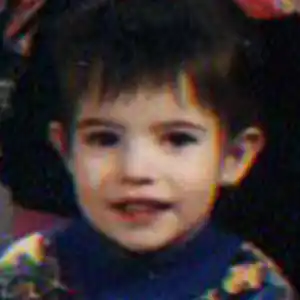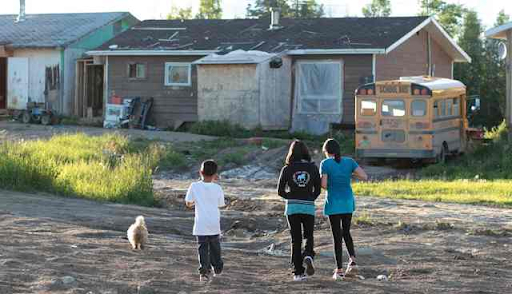Creating an end to violence against Native women and girls (Indian Law Resource Centre n.d.)
By: Simoni Parikh
There is no justification for why Indigenous women have been long victims of violence. Is it their ethnicity? Their being female or the very nature of our society? One could attribute it to all those reasons but above all that, there are no actions being taken to dispel such crimes. The acts of violence against Indigenous women are carried out primarily due to the preconceived notions of our society. As a result, these women's safety and well-being are compromised and the perpetrators escape justice.
Amanda Jean Simpson, an innocent-playful four-year-old was brutally murdered by her stepfather. On October 30th, 1999, she was taken to a hospital in Prince George, British Columbia, by her mother and stepfather for massive head and abdominal injuries.
After being in a coma for three days, Amanda Jean Simpson was later pronounced dead. Although Amanda’s step-father was charged by the local Prince George RCMP, the same charges were applied to him when Amanda was alive. New charges were never made against him.

Four-year-old Amanda Jean Simpson (CBC n.d.)
Several days before the four-year-old Amanda Simpsons’ death, her younger sister had told a trusted adult about her home life and how she was being beaten up by her stepfather. The exact words that left Aimee Simpson’s mouth were, “Please save me.”
When the trusted adult had contacted a local child welfare agency in Prince George, BC for the second time within three weeks for suspected abuse in the home, the child protection worker did not investigate the situation but later suggested that Aimee should be counselled to tell the difference between fiction and real-life.
Aimee Simpson was three years old when her beloved sister Amanda passed away and to this date, she believes that she was killed.
“I know she would have grown tall and beautiful like all my other sisters,” said Aimee. “I think about her a lot and I miss her very much.” “Amanda was Métis, and Aimee thinks it’s time for a federal inquiry into murdered and missing women.” She said it “should have been the next step quite a while ago.” “Aimee is still hoping for answers to her sister’s death and says eventually, she hopes to see the “inside of a courtroom.” “It hurts me to know my sister never got to live her life, and even more that no one cares to figure out why,” said Aimee” (CBC n.d.).
The night that Amanda suffered from those injuries, she was being cared for by her stepfather while her mom was out working. Later when the case was brought to attention, the pediatrician testified that Amanda had a fractured skull, internal and external bleeding in her brain, a broken collarbone, severe hypothermia, and retinal hemorrhaging. Three other medical experts testified that the four-year-old’s injuries did not match the stepfather’s version of the events and the severe injuries were not related to the step-father’s story.
Amanda and Aimee’s stepfather claimed to the RCMP that Amanda had fallen down the stairs and a short time later she had slipped when he was holding her in the tub.
The officials later classified her death as a homicide.
In 2004, the case closed but in 2007, a coroner’s inquest was held in order to determine what happened to Amanda. A short time later, the Prince George RCMP told the media that Amanda’s file was not closed but was under review with the transcript of the coroner’s inquest. To date, there have been no new charges laid concerning Amanda’s death and her family is still seeking answers. The RCMP has failed to respond to multiple requests about the status of Amanda’s case.
Stories like Amandas’ worry us about families that have suffered from such traumatic experiences. Have they found justice? Are they satisfied with the result of their life-changing experiences? Are they still grieving? There are so many things to address, but without a negotiator and a person with power, they will never find peace.
According to several reports over the past couple of years, it is evident that the government policies have broken apart as well as impoverished several Indigenous families and communities. This has threatened hundreds of Indigenous women and girls from leading a normal life. The violence against women and girls has been pointed in several directions including racism, poverty, and marginalization of Indigenous Peoples in our country.
Although Canada has struggled with accepting and acknowledging different cultures and traditions in the past, the recent inequalities of living conditions as well as discrimination have pushed many individuals to precarious situations. For example, inadequate housing, sex work, (where the risk of violence increases each second) and inequalities of services have not allowed many women to escape their toxic environments.
“We need to have some action. The families of the missing and murdered women and girls and two-spirited (individuals), we're tired of talk. If you're going to talk the talk, walk the walk. And I'm not seeing that” Native Women's Association President Lorraine Whitman said last May” (Taylor 2021).
It is hard to see or hear other individuals go through events that leave a permanent scar in their lives as women. It is important to speak and raise awareness for those who have not received justice in the madness of this world. We must advocate for women and girls who have not been able to use their voices to receive justice and make sure they are heard.
Statistics Canada states that in Canada, the national homicide rate for Indigenous women is greater than seven times the amount of non-Indigenous women.
For over two decades, the violence against Indigenous women and girls has continued to grow. Since 2018, approximately sixty-one percent of Indigenous women have been suffering from psychological, physical, or sexual intimate partner violence. Latin Americans, Arabs, and Black women are more likely to have experienced intimate partner violence.

“An eagle feather is held up during a rally for Missing and Murdered Indigenous Women and Girls on Parliament Hill in Ottawa on October 4, 2016" (Wyld 2016).
Due to rates of intimate partner violence, it is more likely for women under the age of twenty-five to be physically assaulted and more than three times likely to be psychologically abused.
According to a report in May 2020, the survey showed that one in five Indigenous women have experienced physical or psychological violence in the last couple of months. “The survey sparked calls from the organization for a national action plan for missing and murdered Indigenous women and girls” (Taylor 2021).
Mattie Stepanek once said, “Unity is strength... when there is teamwork and collaboration, wonderful things can be achieved” (Stepanek 2014).
The Native Women’s Association of Canada (NWAC) is an organization that is committed to helping heal women in our society. One of their many mottos is, “No matter what your situation, you do have options and there is a way out, do not give up!” The Native Women’s Association of Canada is a place where they provide several resources and opportunities to figure out how you could either leave a toxic relationship or how an individual could identify abusive environments. The NWAC provides a detailed step list on what to do in precarious situations. For more information visit their handbook, https://www.nwac.ca/wp-content/uploads/2018/09/2018-Yana-Handbook-English-Final.pdf.
Works Cited
“Missing and Murdered Aboriginal Women.” CBCnews, CBC/Radio Canada, www.cbc.ca/missingandmurdered/?profileID=amanda-jean-simpson.
Taylor, Brooke. “6 In 10 Indigenous Women Experience Physical or Sexual Abuse: Statistics Canada.” CTVNews, CTV News, 20 May 2021, 8:03PM, www.ctvnews.ca/canada/6-in-10-indigenous-women-experience-physical-or-sexual-abuse-statistics-canada-1.5435599#:~:text=Text%3A,10%20in%20non%2DIndigenous%20women.
“VIOLENCE AGAINST INDIGENOUS WOMEN AND GIRLS IN CANADA: A SUMMARY OF AMNESTY INTERNATIONAL’S CONCERNS AND CALL TO ACTION.” Amnesty.ca, Feb. 2014, www.amnesty.ca/sites/amnesty/files/iwfa_submission_amnesty_international_february_2014_-_final.pdf.


This article gave a lot of insight about Indigenous women, thanks for teaching me something new!